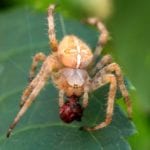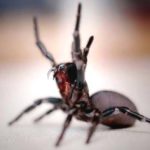 Mysteries
Mysteries  Mysteries
Mysteries  History
History 10 Surprising Stories About the Texas Rangers
 Humans
Humans 10 Philosophers Who Were Driven Mad by Their Own Theories
 Miscellaneous
Miscellaneous 10 Video-Game-Worthy Weapons and Armors from History
 Weird Stuff
Weird Stuff 10 Psychics Who Accurately Predicted Wartime Events
 The Arts
The Arts 10 Pieces of Art Inspired by a Broken Heart
 Health
Health 10 Science Fiction-Sounding New Medical Treatments
 History
History 10 Surprising Facts About the Father of Submarine Warfare
 Space
Space Ten Astonishing New Insights into Alien Worlds
 Weird Stuff
Weird Stuff 10 Bizarre Summer Solstice Rituals Still Practiced Today
 Mysteries
Mysteries Top 10 Haunting Facts About the Ghost Ship MV Alta
 History
History 10 Surprising Stories About the Texas Rangers
 Humans
Humans 10 Philosophers Who Were Driven Mad by Their Own Theories
Who's Behind Listverse?

Jamie Frater
Head Editor
Jamie founded Listverse due to an insatiable desire to share fascinating, obscure, and bizarre facts. He has been a guest speaker on numerous national radio and television stations and is a five time published author.
More About Us Miscellaneous
Miscellaneous 10 Video-Game-Worthy Weapons and Armors from History
 Weird Stuff
Weird Stuff 10 Psychics Who Accurately Predicted Wartime Events
 The Arts
The Arts 10 Pieces of Art Inspired by a Broken Heart
 Health
Health 10 Science Fiction-Sounding New Medical Treatments
 History
History 10 Surprising Facts About the Father of Submarine Warfare
 Space
Space Ten Astonishing New Insights into Alien Worlds
 Weird Stuff
Weird Stuff 10 Bizarre Summer Solstice Rituals Still Practiced Today
10 Human Innovations Inspired by Spiders
They’re creepy. They’re crawly. They’re literally everywhere we go, whether we notice them or not. They’re also the inspiration for innovation! What?
Most of us don’t want spiders anywhere near us. It’s always unsettling when they sneak up on us in the shower, while sleeping, walking into an unseen web, suddenly leaping massive distances, or appearing abruptly from a crevice. Their reputation even prompts thoughts of burning down our homes when we come across them! Some are huge, some are deadly, most are harmless, and they eat a lot of things that can harm us.
But it turns out they can inspire much more than fear or super-humans who can sling webs and save those in peril. Who knew these frightening, little, eight-legged creatures could give us way more than we ever imagined. Here are 10 innovations we can thank these little “horrors” for influencing. So maybe they’re not as bad as we like to believe they are. Our nightmares are giving way to dreams of a brighter future.
Related: 10 Strange Facts And Mysteries Involving Spiders
10 Better Than Band-Aids: Surgical Tape That Adheres to Wet Surfaces
Chances are you have definitely needed a band-aid, stitches, or gauze and medical tape to keep a healing wound clean at some point in your life—unless you live in a padded room with no sharp edges anywhere and don’t have any fingernails (but that’s a whole other list). So you probably also know how annoying it can be to have to constantly replace them when they get wet and start slipping around, losing their original purpose. So frustrating…and a bit expensive over time. Here come spiders to save the day and your skin.
Scientists at MIT are in the process of perfecting a surgical tape that can adhere to and seal wounds in seconds by using water the same way spider webs absorb water, resulting in a stickier insect grabber. It is a two-sided adhesive with an incredibly strong bond and has been successfully tested on pig skin and lungs. They used a polyacrylic acid to absorb the water and create a bond reinforced by gelatin that will break down harmlessly in the body as the wound heals. No need to schedule a second appointment for stitch removal or itchy rashes from adhesive medical tape. That sounds pretty great.[1]
9 Step Back, Kevlar: Spider Silk Body Armor
Kevlar may become an invention of the past even though it, too, was inspired by spider silk. The light, intensely strong polymer used in things from body armor to sailboat sails pales in comparison to some of its newer off-shoots also developed from that sticky elastic that we’ve all unknowingly and unhappily wandered into at some point.
It takes 33 layers of Kevlar to stop a .22 caliber bullet. But a new material, dubbed “Dragon Silk,” made from silk produced by Golden Orb Weaver spiders, can stop the same caliber bullet with only 4 layers. Now that is impressive! It’s so promising that the U.S. Army has invested in its production and expects to be using it extensively in the future. It has taken millions of spiders to create what they have so far. Thank you for your service, you webby geniuses.
And then, there is artificial silk resulting from work being done at Washington University in St. Louis that is called “polymeric amyloid” fiber. This is a derivative of spider silk created from an “engineered bacteria that produced a recombinant silk with performance on par with its natural counterparts in all of the important mechanical properties.” The aim is now to create something even stronger than spider silk. Turns out smarty human brains, bacteria, and spiders make a great team.[2]
8 Webs Used for Micro-Imaging: Tiny Dome Lenses
The medical world is really fostering a love for incredible spider abilities. At the Tamkang and Yang-Ming Universities in Taiwan, researchers are designing minuscule lenses that can be used for imaging inside a human body. These lenses are so small that they are almost comparable in size to a red blood cell. So they’ll pretty much be able to go anywhere in the body blood goes…so everywhere. That has some extremely promising applications.
They did this by using the actual “dragline silk” of Daddy Long Legs used to frame their webs. A resin was then dripped over the silk frame and baked inside of an ultraviolet oven. As a result, the lenses are also bio-friendly in the body and capable of nanoscale imaging. It could be truly revolutionary for medical research and far less invasive than current technologies. Wouldn’t it be awesome if we ended up with Spidey-senses as a side effect?[3]
7 Cheeky Devils!: Spider Venom May Be Better Than Viagra
Men who have had the misfortune of being bitten by one of the world’s most venomous spiders, The Brazilian Wandering Spider, have had another detailed side effect beyond pain and torture…very persistent erections. Now there is no recommendation to go find one of these nightmare-inducing beasts and goad it to bite you before a private get-together! But science has taken a cue and some toxins from them to fabricate a gel that achieves the same result.
Granted, the BZ371 gel probably needs a more enticing moniker for the public. But it apparently does its job very well within 20-30 minutes of application without any stimulation, with no side effects as well. And it is reported to last for about 60 minutes. Let’s help out the marketing departments. What are some good names for this wonder gel?[4]
6 Eight Spindly Limbs: Inspiration for More Efficient Robots
Even if the spiders’ crawl sends chills up your spine, you have to admit it’s one of a kind and lets them do some very remarkable things. If we could all move as well as they do, we’d be fairly unstoppable. Unfortunately, we’re just six legs short with very limited joint direction and flexibility. Even practicing yoga for eight hours a day will never get us anywhere close to the movements of our arachnid brethren. But this ability hasn’t been lost on the robotics world.
Researchers have created limbs and joints in imitation of spider legs that allow greater functionality and fewer components needed for robots used in many different ways. The results are much lighter, smaller parts with superior mobility that can be used in virtually any robot. It has been hailed as a true leap forward in the robotics field. High-eight, Spiders!…but from way, way over there, please.[5]
5 We Can All Potentially Be Spider-Man!: Real Web Shooters
Who hasn’t wanted to be able to shoot webs after watching or reading Spider-Man? It’s one of those things you pretend you can do even as an adult play-acting alone because it’s so cool (don’t lie, you can admit it—this is a safe place!). Rest assured, someone is working on making it come to life. It may even allow us to swing from building to building eventually as they are perfected. Well, maybe by those physically adept enough to do some gymnastic-like stunts or parkour. Time to start working on that upper body and core strength.
A mechanical engineer and YouTuber from South Africa named JT has created some pretty awesome web-shooters for a thesis project that he has featured on his channel, Built IRL. This is one you’re going to search immediately—because why wouldn’t you? He uses metal cylinders with a long cable embedded with metal hooks that can grab onto metal bars. They’re powered by compressed propane and “a custom-designed igniter.” It’s fun to see life inspired by art stolen from something that truthfully creeps most of us out! Go Spidey-JT.[6]
4 Trendy, Functional Spider-Wear: Sustainable Web-Inspired Fashion
Now, let’s just admit that the fashion world can take things way too far and look pretty ridiculous in practical life. Of course, these are opinions of someone whose fashion sense is comfortable, plain sneakers, a blank T-shirt, and yoga pants or jeans. Not exactly runway ready! But fashion change can also energize and galvanize an industry that has become environmentally unfriendly with its throw-away culture, synthetic fibers, and toxic processes. Here come spiders to the rescue, again.
A company called Bolt Threads, the first of its kind, has bioengineered a yeast with a spider silk protein gene. As the yeast ferments, it creates a silk protein that is then purified and spun into a textile called MicroSilk. Adidas has already used a hybrid of this material to make a lightweight tennis dress. Another company, AMSilk, has produced a similar material called BioSteel which Adidas has used in a sneaker. And now it seems the airline industry is becoming more interested in these synthetic silk materials because of the weight reduction. Innovation that mimics nature to save nature. Glorious.[7]
3 Poison Can Kill Pain: Tarantula Venom Could Replace Opioids
We’ve all recently become aware of how real, destructive, and threatening the widespread use of synthetic opioids has become. The side effects can come in many forms: rash, constipation, nausea, respiratory distress, even addiction, and more. The need for alternative pain treatments for people suffering chronic and neuropathic pain is real, and science is on the case.
At the University of Queensland, researchers have found molecules in tarantula venom from the Chinese Bird Spider that can be developed into mini proteins that adhere to pain receptor cells. When used in the correct amount, it can surround the cell membrane around the pain receptors, blocking their abilities. And so far, there have been no recorded side effects.
Now, that is real relief. All the studies have been done on mice for now, but the results are very optimistic for future pain reduction. Who would have ever thought something that delivers some vicious pain could also be used to combat it? Gotta love, or at least appreciate, science.[8]
2 Spider Silk Milk: Goat Genes Manipulated to Produce Spider Silk
Move over, Dr. Frankenstein! Biomimicry science is growing leaps and bounds. We’re finally taking more lessons from nature instead of trying to dominate her. A company called Nexia has been genetically manipulating goat eggs with Golden Orb Weaver silk genes to create goats that produce spider silk proteins along with their milk. This is possible because the glands in goats that make milk and the glands in spiders that produce silk are very similar. And goat milk has been used to produce other medicines too. So it was a reasonable leap in the scientific mind despite the inevitable controversy.
But, why, right? It’s somewhat common knowledge that spider silks are as strong as or stronger than steel. This strength, along with the flexibility and durability, could have a huge array of usable applications in our daily lives, from engineering buildings and roads in earthquake-prone areas to surgical grafting. So mass-producing the silk is an attractive idea. It’s still not up to snuff with what the spiders can make…yet. But they’re going to keep on weaving until it gets there.[9]
1 Reflective Webs Can Save Birds: UV-Reflective Glass
Birds have a very unique aspect to their vision; they can see ultraviolet light. How many birds have collided with the glass in your home’s windows? That loud, telling thud is usually startling and occasionally damaging to the glass. Some birds are just stunned for a bit, and some end up quite dead. Well, it turns out that spider webs reflect ultraviolet light that our feathered friends can see. This is why they don’t have to constantly rebuild those dainty insect death traps with all the birds sharing the same spaces. Instead, our feathered friends can see them to avoid them, saving the spider time and work and the bird a sticky, unwanted mess. That’s actually pretty cool!
This discovery inspired a German glass company, Glaswerke Arnold, to develop the Orinlux Bird Protection Glass. Buildings that use this glass embedded with UV-reflective strands have reportedly had 75-90 percent fewer bird strikes. To us, the windows just look like your average, transparent pane of glass while the “invisible,” chaotic, UV patterns warn birds there is no open air to soar through. It was developed in 2006 and is finally taking hold across many new buildings while being projected to be very widely used in the near future. Yay for bird safety and spider inspiration![10]
+ Spider Music!
If you haven’t heard it yet, people have now used the construction of spider webs to create music with 3-D video, and it’s as eerie as you would imagine it to be! Have a listen. Spider Canvas was a collaborative project between MIT’s CAST faculty, a Ph.D. student in the Civil and Environmental Engineering department, the head of the same department, a Music and Theatre Arts lecturer, and a composer and video artist.
This amazing web of work is truly beautiful and haunting. Halloween just got a new theme song.[11]








